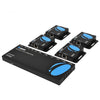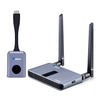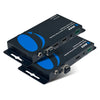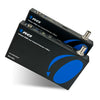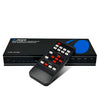How to mirror content across 16 distinct displays effectively?

Imagine this: you are manning the store of your bustling business, about to showcase a promotional video that’s bound to increase your sales. As you start thinking of a way to let your customers see it, you realize you don’t have a way to simultaneously display it across your store. Here’s where HDMI splitters can be the solution to your problems – more specifically, a 1x16 HDMI splitter.
In this blog, let’s discover how this technology can help transform your business and give your establishment a dynamic edge that can captivate all your customers.
Let’s start with a brief background on what an HDMI splitter is.

An HDMI splitter is a device that takes content from a single source, such as a laptop or gaming console, and sends it to multiple displays simultaneously. This allows you to share presentations, videos, or other content across multiple screens, making it ideal for businesses, events, and entertainment setups. It's a powerful tool for enhancing visual experiences and engaging your audience on a larger scale.
So with that being said, what is an HDMI Splitter 1-in 16-out?
Say you're a presenter, standing in front of a room filled with eager faces and you've got a knockout presentation on your laptop. But here's the thing: not everyone can see your screen clearly. That's where the 1x16 HDMI splitter shines. It takes your presentation and beams it onto 16 screens scattered across the room. Everyone gets a front-row seat, no squinting required.
Or perhaps you're an educator in a bustling classroom. You want everyone to enjoy that educational video you found. Instead of crowding all your students around one screen, a 1x16 HDMI splitter can spread that content across 16 screens so every student gets a crystal-clear view, and the lesson becomes a captivating experience.
Now, let's switch to the entertainment scene. You're at a sports bar, and the big game is on. Every eye in the place is glued to the screens, but they're not all facing one direction. That's where the 1x16 HDMI splitter steps in. It turns one epic game into a show that everyone can catch, no matter where they're seated.
An HDMI Splitter 16-port is like a superpowered splitter that’s built for content distribution. It can easily take content from a single input and distribute it across 16 different displays up to 40 feet away. It’s also good to know that there are available 4K HDMI splitters capable of displaying your UHD content across all screens so everyone can enjoy crystal-clear content from every corner of your establishment.
Preventing a cabling nightmare
By now, you’re probably thinking how hard it might be for you to set up 16 different TVs for your business or your classroom. Don’t worry! You can use these tips to help make sure that setting up your displays is a breeze.
-
Plan Your Display Setup: Before you do some actual cabling, make sure that you know where your displays go. A great way to do this is by physically placing your TVs in their respective locations. Once you’re done, move on to the next step.
-
Plan Possible Cabling Routes: Because you have to connect your TVs to your splitter, you have to route cables. You can route your cables on the wall, ceiling or floor. However, be reminded that it’s only recommended that you use up to 30 feet of cable. Plan wisely.
- Avoid Interference: Power cables tend to cause interference with HDMI cables. Once this happens, you may encounter some signal issues. Try keeping these cable types apart.
-
Tag Those Cables: To avoid future confusion, label your cables. A simple numbering system on both ends of each cable greatly helps you keep track of which cable goes where.
- Organize and Secure: To prevent any cable tangles and potential hazards, use cable clips or ties to keep cables neat and tidy. Not only does it keep any passerby safe, it also makes your setup look good.
Seems easy enough, right? For the next part of this discussion, let’s go through how you can connect your 16 displays to your splitter in just a few simple and easy steps.
How to set up your 1x16 HDMI Splitter
- Gather your gear. Collect your 1x16 HDMI splitter, HDMI cables, and your input device (like your laptop, computer, etc.) in one area. If your HDMI cables are already routed, make sure they all lead to your main control area, or the location where you’ll be placing your HDMI splitter.
- Connect all HDMI cables to the output ports on your splitter, and connect your input device as well.
- Connect your splitter to a power source. Use the power cord and adapter that came with your device to prevent electrical issues.
- Connect the other end of your HDMI cables to your displays.
- For testing purposes, power up all your devices – this includes your splitter, input device, and output displays.
- Load your content from your input device, and it should appear on all display outputs.
If there are displays that aren’t functioning properly, check if the cables are connected firmly or follow some troubleshooting tips. This may be included in your splitter’s user manual.
That’s it. You can now reap the benefits of having multiple displays for whatever purpose you might need! Do you want to get started?
Check out this OREI HDMI Splitter! The OREI UHDS-1016 is a 1x16 HDMI splitter that supports up to 16 different outputs, with a display quality of up to 4K@60Hz. It also comes with an EDID switch that can help you manage display quality across all monitors, especially if they have different supported resolutions.
This device is HDMI 2.0b and HDCP 2.2 compliant, which means that you can use it to stream most types of HDMI content. It supports a wide variety of audio formats as well, such as PCM 2.0/5.1/7.1CH, Dolby 5.1, DTS 5.1, Dolby TrueHD, and DTS-HD.
Interested in learning more about the UHDS-1016? Learn more about this OREI HDMI Splitter 1-in 16-out by clicking here.
Discover more about HDMI splitters by exploring our blog!


